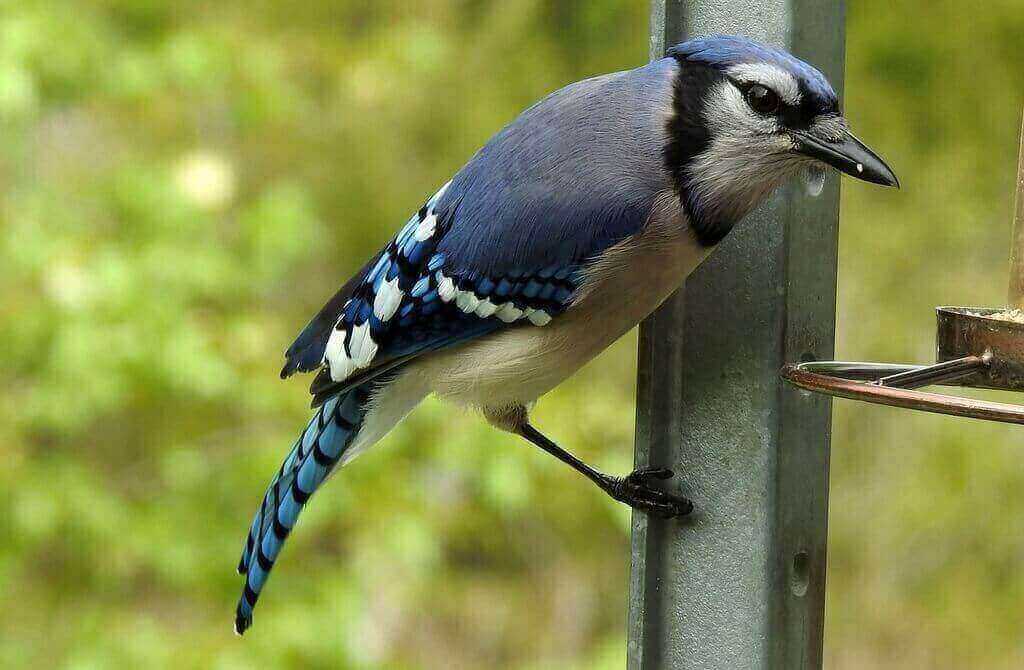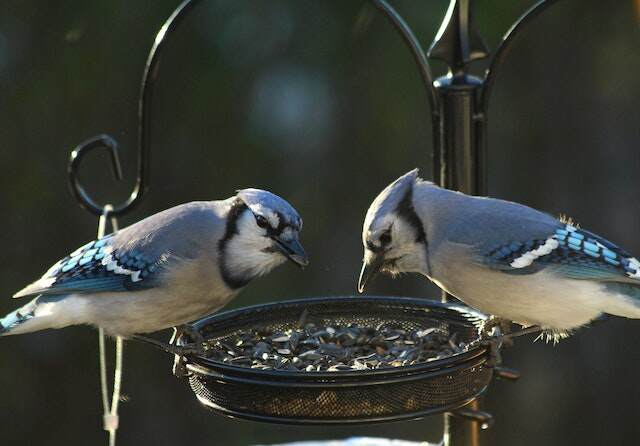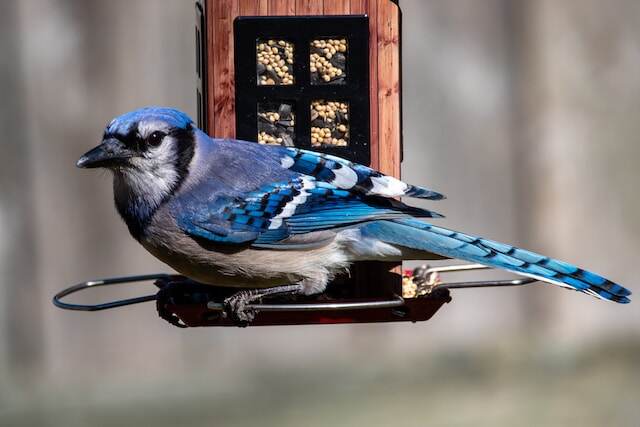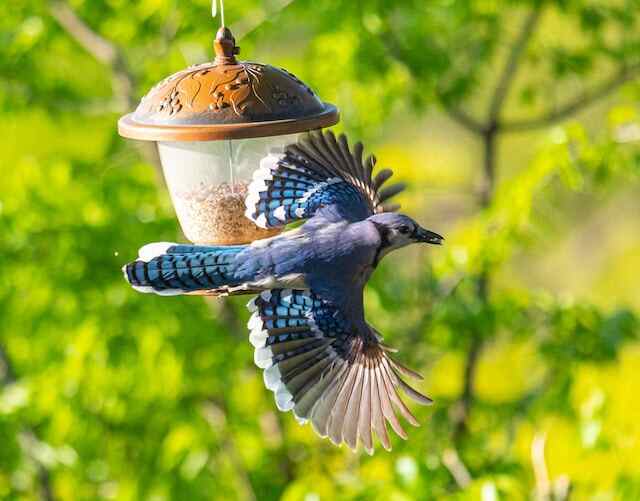Have you ever wondered what entices blue jays to visit your yard? These vibrant and intelligent birds bring joy to any outdoor space with their striking appearance and melodious calls. In this guide, we’ll explore the fascinating world of blue jays and explore the secrets to attracting them to your yard. From providing the right food to creating an inviting habitat, discover how you can make your yard a haven for these stunning avian visitors.
Table of Contents
- 1 Key Takeaways:
- 2 What Attracts Blue Jays to Your Yard?
- 3 Understanding Blue Jay Feeding Habits
- 4 Creating a Blue Jay-Friendly Yard
- 5 Choosing the Right Foods to Attract Blue Jays
- 6 Placement and Presentation of Blue Jay Food
- 7 Enhancing Your Yard to Attract Blue Jays
- 8 Nesting Boxes for Blue Jays
- 9 Common Mistakes to Avoid
- 10 Dealing with Blue Jay Predators
- 11 Extra Tips
- 12 Conclusion
- 13 FAQs: What Attracts Blue Jays to your Yard?
- 13.1 What factors attract Blue Jays to your yard?
- 13.2 What are Blue Jay feeding habits?
- 13.3 How can I attract Blue Jays to my yard?
- 13.4 What are Blue Jay’s favorite foods?
- 13.5 How should I place and present Blue Jay food?
- 13.6 How can I enhance my yard to attract Blue Jays?
- 13.7 Should I provide nesting boxes for Blue Jays?
- 13.8 What are common mistakes to avoid when attracting Blue Jays?
- 13.9 What are Blue Jay predators, and how can I deter them from my yard?
- 14 Author
Key Takeaways:
- Understanding Blue Jay feeding habits is essential in attracting them to your yard
- Providing the right food and creating a suitable environment can entice Blue Jays to visit your outdoor space
- Avoiding common mistakes and dealing with predators are important considerations when attracting Blue Jays to your yard
| Coloration | Range | Habitat | Diet | Length | Weight | Wingspan | |
|---|---|---|---|---|---|---|---|
| Blue Jay | Blue, white, and black plumage with perky crest | Eastern and central North America | Forests, woodlands, parks, and gardens | Omnivorous, eats insects, nuts, seeds, and fruits | 22-30 cm (9-12 in) | 70-100 g (2.5-3.5 oz) | 34-43 cm (13-17 in) |
What Attracts Blue Jays to Your Yard?
Blue Jays can be attracted to your yard by providing food sources such as roasted and unsalted nuts, whole peanuts, seeds, grains, corn, mealworms, fruits, berries, and sunflower seeds. Blue Jays also prefer platform feeders and blue-jay-friendly feeders.
Additionally, planting fruit-bearing shrubs and nut-bearing trees, as well as offering water sources, can help attract Blue Jays to your yard. Providing perches like tree stumps or branches can also provide additional resting and feeding areas for Blue Jays.
Understanding Blue Jay Feeding Habits
Blue Jays have diverse feeding habits, making them an interesting species to observe in your yard. Understanding their food preferences is crucial for attracting them to your outdoor space.
| Food Preferences | Description |
|---|---|
| Nuts | Blue Jays love nuts, particularly acorns and beech nuts. Peanuts and sunflower seeds are also popular choices. |
| Fruit | Blue Jays enjoy fruit, including cherries, grapes, and blueberries. Offering a fruit feeder can be a great way to attract them to your yard. |
| Insects | While not as commonly eaten as nuts and fruit, Blue Jays will consume insects such as grasshoppers and caterpillars if they are available. |
It’s important to note that Blue Jays are not picky eaters and will feed on a wide variety of foods. However, they are known to be attracted to higher-quality foods and will often return to areas where they find their favorite snacks.
If you wish to provide Blue Jays with a diverse diet, you can offer a mix of nuts, fruit, and insects. Avoid feeding them bread as it provides little nutritional value and can be harmful to their health.
By providing the right foods, you can attract a variety of beautiful Blue Jays to your yard.
Creating a Blue Jay-Friendly Yard
Attracting Blue Jays to your yard involves more than just providing food. These birds have specific nesting and habitat preferences that must be taken into consideration. By transforming your outdoor space into a Blue Jay-friendly environment, you can increase your chances of attracting these stunning birds.
Understanding Blue Jay Nesting Habits
Blue Jays typically build their nests in trees, usually located in the fork of a branch or near the trunk. The nest is a cup-shaped structure made of twigs, grass, and sometimes mud. You can attract Blue Jays to your yard by providing suitable nesting opportunities.
If you have tall trees in your yard, consider leaving a dead tree or limb in place to provide a natural nesting spot. Alternatively, you can install a nesting box designed for Blue Jays.
Creating Blue Jay Habitat Preferences
In addition to nesting opportunities, Blue Jays prefer habitats with dense foliage and open spaces, as they are both ground feeders and canopy dwellers. Incorporating plants and shrubs that provide cover and perching opportunities can attract these birds to your yard.
Consider planting berry-producing shrubs, such as serviceberry or elderberry, as these are among the Blue Jay’s favorite food sources.
Transforming Your Yard
Creating a Blue Jay-friendly yard also involves making changes to your yard’s layout and features. For example, installing a bird bath or pond can provide a source of water for drinking and bathing.
If you’re searching for a nice bird bath to complement your yard, I would recommend this Sunnydaze birdbath. The birds will thank you for it, and it will add a stylish touch to any yard. You can find it on Amazon.
Adding perches, such as tree stumps or branches, can provide additional resting and feeding areas.
Additionally, reducing the use of pesticides and herbicides can create a safer and healthier environment for Blue Jays and other birds.
Choosing the Right Foods to Attract Blue Jays
Blue Jays are opportunistic feeders, and their diet consists of insects, nuts, seeds, fruits, and occasionally small animals such as mice or frogs. However, there are specific foods that Blue Jays favor, which can help attract them to your yard.
One of the Blue Jay’s favorite foods is peanuts. You can offer raw or roasted peanuts in or out of the shell. Peanuts can be placed in a tray or platform feeder, or you can create a peanut wreath to hang from a tree branch. The wreath can be made by stringing unsalted, shelled peanuts on a wire and then bending the wire into a circle.
Another favorite food of Blue Jays is sunflower seeds. While black oil sunflower seeds are the most popular, striped sunflower seeds are also acceptable. These can be offered in a tube feeder or hopper feeder, or scattered on the ground.
| Blue Jay Favorite Foods | How to Offer |
|---|---|
| Peanuts (raw or roasted) | Tray or platform feeder, peanut wreath |
| Sunflower seeds (black oil or striped) | Tube or hopper feeder, scattered on the ground |
| Suet | Suet feeder |
| Fruit (apple, grapes, berries) | Tray or platform feeder, scattered on the ground |
| Corn (shelled or cracked) | Tray or platform feeder, scattered on the ground |
Suet is another food that Blue Jays enjoy. You can offer suet cakes in a dedicated suet feeder. Fruit, such as sliced apples, grapes, or berries, are also a favorite of Blue Jays and can be offered in a tray or platform feeder, or scattered on the ground. Corn, either shelled or cracked, can also be offered in a tray or platform feeder or scattered on the ground for Blue Jays to enjoy.
When offering food to Blue Jays, it’s important to note that they prefer to feed on a flat surface, so using a tray or platform feeder like this one from Nature’s Way is ideal. Also, make sure to place the food in an open area where Blue Jays can easily access it, but not too close to cover where predators may lurk.
If you’re worried that platform feeders will attract unwanted animals, I would then recommend using the Woodlink Absolute II Bird Feeder with a premium mix like Wagner’s Gourmet Bird Food.
This type of feeder is designed to be squirrel-resistant, which can help keep the area clean and free of any mess and eliminates attracting unwanted guests like raccoons, mice or rats.
Placement and Presentation of Blue Jay Food
Knowing what types of food Blue Jays prefer is just the first step in attracting them to your yard. Proper placement and presentation of the food is also critical in enticing these birds. Here are some expert tips on how to attract Blue Jays with food:
- Provide food at consistent times: Blue Jays are creatures of habit and will often visit the same feeding area at the same time each day. To maximize your chances of attracting them, try to offer food at consistent times each day.
- Place food in open areas: Blue Jays prefer to feed in open spaces where they have a clear view of their surroundings. Avoid placing food in areas surrounded by dense foliage or tall trees.
- Use platform feeders: Blue Jays prefer to feed from platform feeders that allow them to easily pick up and carry away food. Avoid tube feeders that restrict their access to food.
- Offer a variety of foods: Blue Jays have diverse diets and prefer to have a variety of foods available. Offer a mix of peanuts, sunflower seeds, cracked corn, and mealworms to attract them.
- Avoid large food pieces: Blue Jays prefer small food pieces that they can easily carry away. Avoid offering large food items such as whole peanuts or long strips of meat.
- Change food frequently: Blue Jays prefer fresh food, so be sure to change the food regularly. Stale or moldy food can cause health problems for birds.
By following these tips, you can maximize your chances of attracting Blue Jays to your yard with food. Remember, it’s not just about offering the right food, but also about how you present it.
Enhancing Your Yard to Attract Blue Jays
Creating a Blue Jay-friendly yard goes beyond offering the right food. Incorporating additional elements in your outdoor space can improve your odds of attracting these birds. Here are some tips on how to enhance your yard:
- Water Features: Blue Jays are attracted to water sources, such as fountains or small ponds. Adding a water feature to your yard can be an effective way of enticing these birds to visit. Ensure that the water source is kept clean and fresh.
- Perches: Blue Jays are known to perch on elevated surfaces while looking for food. Provide perching options such as tall trees, birdhouses or even tall poles around your yard. These perches also double up as potential nesting spots for Blue Jays.
- Vegetation: Blue Jays like to forage in areas with dense vegetation. Plant native trees and shrubs around your yard to provide them with cover and shelter. Avoid using pesticides or herbicides that can harm these birds directly or indirectly.
Remember, a well-maintained yard is critical in creating a Blue Jay-friendly environment. Bare soil patches or unkempt bushes can deter these birds from visiting your yard. Keep your yard clean and tidy to increase your chances of attracting Blue Jays.
Nesting Boxes for Blue Jays
Blue Jays are known to nest in trees, but providing nesting boxes in your yard can encourage them to stay and breed closer to your home. Nesting boxes can offer a safe and comfortable space for Blue Jays to raise their young, providing you with the pleasure of their presence for generations to come.
When choosing a nesting box, it’s essential to select one that is designed specifically for Blue Jays. The box should be made of natural materials and constructed with a large entrance hole that will fit the birds comfortably. One product that I would highly recommend is the Coveside Nesting box. You can find it on Amazon.
It’s also important to place the nesting box in a location that is safe and secure. Blue Jays prefer to nest high off the ground, so it’s recommended that you mount the box at least eight feet above the ground on a sturdy tree or post.
When preparing the box for use, make sure that it is clean and free of debris or any previous occupants. Adding a bit of wood shavings or other non-toxic nesting material to the box can help make it more inviting to Blue Jays.
Providing nesting boxes is a great way to enhance your yard and attract Blue Jays. With the right location and preparation, you can enjoy the beautiful sight of these birds nesting and raising their young right in your own backyard.
Common Mistakes to Avoid
While trying to attract Blue Jays to your yard, it is essential to avoid common mistakes that may drive them away. Understanding Blue Jay behavior patterns is crucial to avoid these mistakes.
One common mistake is failing to provide enough food or the right type of food. Blue Jays prefer food that is high in fat and protein, such as peanuts or sunflower seeds. Offering food that is spoiled or of poor quality may also deter Blue Jays from visiting.
Another mistake is not placing the food in a suitable location. Blue Jays prefer to feed in areas with cover, such as trees or bushes. Placing the food in an open area may make them feel exposed and at risk of predation.
Additionally, using bird feeders that are not suited for Blue Jays may cause stress or injury to these birds. Blue Jays require larger perches and feeding ports to accommodate their size and feeding habits.
Finally, creating an environment that is hostile to Blue Jays can also discourage them from visiting your yard. Loud noises, bright lights, and the presence of predators or other animals can be alarming to these birds and cause them to avoid the area.
To attract Blue Jays successfully, it is essential to avoid these common mistakes and provide a safe and suitable environment that meets their specific preferences.
Dealing with Blue Jay Predators
Blue Jays have natural predators, and it’s important to be aware of them when creating a Blue Jay-friendly yard. The most common predators of Blue Jays are cats, squirrels, and other birds such as hawks and owls.
To deter predators, avoid placing bird feeders or nesting boxes close to trees or structures that predators can climb or jump from. Instead, hang feeders and boxes from poles or wires that are at least 6 feet off the ground and away from any nearby obstacles.
Another effective way to deter predators is to keep a well-maintained garden. Keeping tall, dense vegetation around the perimeter of your yard can act as a natural barrier, making it more difficult for predators to access your bird feeders or nesting boxes. Additionally, keeping your yard free of debris and clutter can reduce hiding spots for predators.
If you notice a predator in your yard, try to scare it away without harming it. Clapping your hands, making noise, or using a water hose can be effective ways to frighten away predators without causing harm to them or the Blue Jays.
By taking these measures, you can reduce the risk of predators in your Blue Jay-friendly yard, creating a safer environment for these beautiful birds to thrive in.
Extra Tips
- You will need a variety of foods available for them, such as sunflower seeds and suet cakes.
- You should also put up bird feeders and even a bird bath if possible.
- Put up nest boxes for them.
- Plant native plants that produce nectar or seeds.
- Provide water at all times of year near your house.
- Blue Jays love oak trees with large leaves and lots of acorns! Plant one in your yard or if there are already some, place some feeders on the ground beneath them, so they can easily find food while perched.
- Blue Jays can’t resist certain food items: apples, corn on the cob, peanuts in shells and sunflower seeds (unsalted). They also enjoy oranges with the peel left on.
- Plant Blue Jay friendly plants like roses and cedar trees in your garden.
- Offer a bird feeder with plenty of sunflower seeds, peanuts and safflower seeds.
- Plant native trees and shrubs in clusters – Clusters of different types of plants will provide food for blue jays throughout the year. These include berry-producing plants like dogwood, holly, sumac and viburnum.
Conclusion
Attracting Blue Jays to your yard can be an exciting adventure. By understanding their feeding habits and creating a suitable environment for them, you can enjoy the presence of these beautiful birds in your outdoor space.
Providing the right food is crucial in attracting Blue Jays. Knowing their favorite foods and presenting them properly can increase your chances of success. Additionally, incorporating water features, perches, and other elements can enhance your yard and entice these birds to visit.
It’s important to be mindful of common mistakes when attracting Blue Jays. Avoiding such mistakes can ensure a successful Blue Jay-friendly environment. Being aware of their natural predators and taking steps to deter them can also enhance the safety of these birds in your yard.
In conclusion, attracting Blue Jays to your yard can be accomplished by applying the expert tips discussed in this article. By providing the right food, creating a suitable environment, and avoiding common mistakes, you can increase your chances of enjoying the presence of these stunning birds in your outdoor space.
Remember, what attracts Blue Jays to your yard is not just a matter of their diet but all the other elements that contribute to the safety and quality of their habitat.
FAQs: What Attracts Blue Jays to your Yard?
What factors attract Blue Jays to your yard?
Blue Jays are attracted to yards that provide the right food and a suitable environment. Understanding their feeding habits and preferences can help attract them.
What are Blue Jay feeding habits?
Blue Jays have diverse feeding habits. They prefer foods like nuts, seeds, and insects. Offering a variety of these foods can attract them to your yard.
How can I attract Blue Jays to my yard?
To attract Blue Jays, provide the right food, such as nuts and seeds, and create a Blue Jay-friendly environment with water features and perches.
What are Blue Jay’s favorite foods?
Blue Jays have specific food preferences. They are particularly attracted to foods like acorns, peanuts, and sunflower seeds.
How should I place and present Blue Jay food?
Blue Jays have specific behavior patterns when it comes to feeding. Place the food in a visible and accessible location, such as on a platform feeder or in a tray.
How can I enhance my yard to attract Blue Jays?
Besides providing food, you can enhance your yard by incorporating water features, perches, and other elements that attract Blue Jays.
Should I provide nesting boxes for Blue Jays?
While Blue Jays typically nest in trees, providing nesting boxes can also attract them to stay in your yard. Set up nesting boxes following proper guidelines.
What are common mistakes to avoid when attracting Blue Jays?
Common mistakes include using incorrect or unsuitable food, neglecting to maintain cleanliness and hygiene around the feeding area, and not providing a suitable habitat.
What are Blue Jay predators, and how can I deter them from my yard?
Blue Jays have natural predators like hawks and cats. To deter them, you can use scare devices, remove potential hiding spots, and create safe perching areas.








